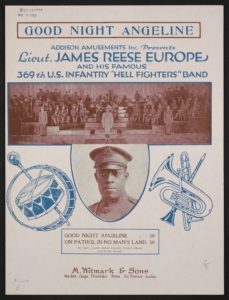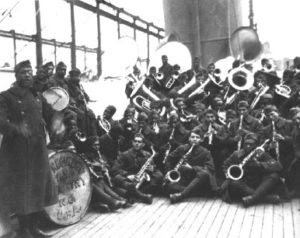 The U.S. got more than it bargained for when it organized two “all-colored” combat units and sent them to France to fight the last year of World War One. While our nation was slow to recognize the great contributions of its “men in bronze,” fearing the impact on American culture of empowered black veterans returning at the end of the war, the French immediately fell in love with the dusky fighting men, embracing them not only for their fierce combat skills, but also for their unique cultural gifts, especially in music. The one hundred-piece band of the 369th Infantry Regiment, known as the “Harlem Hellfighters Band” became an instant favorite of the French. Accomplished musicians when they entered the army, and led by the incomparable ragtime and jazz composer, arranger and bandleader James Reese Europe, they captivated European audiences with their until-then unknown jazz music. Audiences created an international demand for the new and distinctly American musical form.
The U.S. got more than it bargained for when it organized two “all-colored” combat units and sent them to France to fight the last year of World War One. While our nation was slow to recognize the great contributions of its “men in bronze,” fearing the impact on American culture of empowered black veterans returning at the end of the war, the French immediately fell in love with the dusky fighting men, embracing them not only for their fierce combat skills, but also for their unique cultural gifts, especially in music. The one hundred-piece band of the 369th Infantry Regiment, known as the “Harlem Hellfighters Band” became an instant favorite of the French. Accomplished musicians when they entered the army, and led by the incomparable ragtime and jazz composer, arranger and bandleader James Reese Europe, they captivated European audiences with their until-then unknown jazz music. Audiences created an international demand for the new and distinctly American musical form.
Jim Reese Europe was the leading figure in the African-American music scene of New York City in the early 1900s. Years later, Eubie Blake who also played with the 369th band called Europe the Martin Luther King of music. In 1912, Europe’s Clef Club Orchestra made history as the first band to play jazz at New York’s famed Carnegie Hall. Presenting a program entirely of the music of black composers, the performance made the city’s cultural elite aware of negro music for the first time. Of the event, Europe commented, “We colored people have our own music that is part of us. It’s the product of our souls; it’s been created by the sufferings and miseries of our race.”

In 1918, Europe and the 369th band saw combat and traveled over 2,000 miles in France performing for British, French and American military audiences as well as French civilians. The Hellfighters made their first recordings in France for the Pathé brothers. Their first concert included a French march, the Stars and Stripes Forever, and the Memphis Blues, which, according to band member Noble Sissle, “… started ragtimitis in France.”
At the end of the war, the 369th returned to New York City, and on February 17, 1919, paraded through the city with its famous band playing and leading the way. The day became an unofficial holiday for all of Harlem, and many school children were dismissed from school so they could attend the parade. 250,000 people lined the streets to see the famous regiment and its band. The parade began on Fifth Avenue and 61st Street, proceeded uptown past crowds of white bystanders, turned west on 110th Street and then north on Lenox Avenue, marching into Harlem where proud black New Yorkers packed the streets to see them. The parade became a marker for African American service to the nation, and was a frequent point of reference in civil rights discussions.
Sadly, after surviving the deadliest war in world history to that point, Jim Europe did not live through the Hellfighter’s national tour. A member of the band, angry over what he considered poor treatment, fatally stabbed Europe on May 10, 1919 ending his amazing life at the age of only 39. Noble Sissle and Eubie Blake assumed leadership of the band which successfully completed its tour and continued performing for many years.